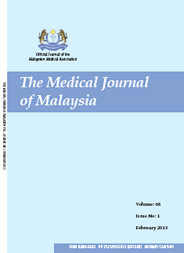MJM, Vol 70 Supplement 1 September 2015
A measles outbreak at a private welfare centre in
Kuala Lumpur, February 2012
*Kuala Lumpur Federal Territory State Health Department, **Muar District Health Office, Johor
ABSTRACT
Introduction: Measles incidence in Kuala Lumpur (KL) increased steadily between 2006 and 2011 from 0-10.1 per 100,000 population. The immunisation coverage was 86.7% compared to standard > 95%. Early February 2012, the State Health Department (JKWPKL) received notifications regarding few measles cases detected among residents of a welfare centre. Investigation was conducted immediately to verify the outbreak and identify the source for preventive and control measures.
Methodology: Cohort study was carried out. Cases defined as individuals staying at the welfare centre with history of fever and rash with conjunctivitis, coryza or cough, from February 2012 with confirmed Measles and epidemiological linked. All residents were interviewed using standard questionnaire. Blood samples were taken for serology confirmation and viral isolation. The environment of the centre was assessed.
Results: A total of 33 at risk residents were identified and 17 of them fulfilled case definition (attack rate 51.5%). Age of cases ranged from 6 months to 14 years old with median 6 years old. The index case contracted measles two weeks before the outbreak. Five out of 8 samples (62.5%) were IgM Measles positive. Contributing factors were non-immunised status (100%, p<0.05) and non-isolation of cases.
Conclusion: Non-immunised residents and low immunisation coverage in the operational area caused low “herd immunity” resulting in measles outbreak in the centre. Fifteen residents aged 6 months to 15 years were given measles vaccination. Isolation room was set up to isolate the infected children. Defaulter tracing and mopping of eligible children for immunisation were done to improve the immunisation coverage.
Keywords: measles outbreak, non-immunised status, low immunisation coverage
